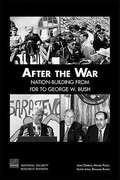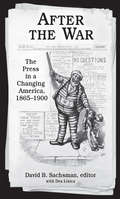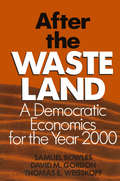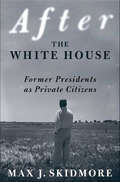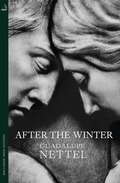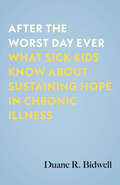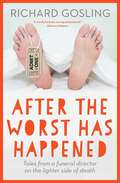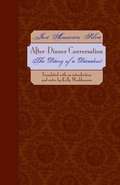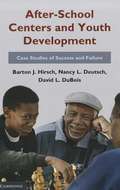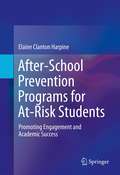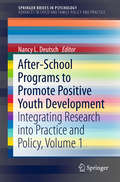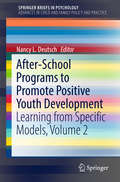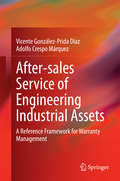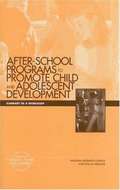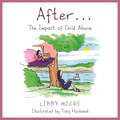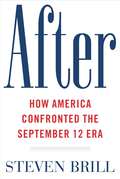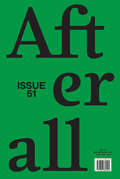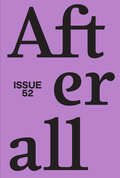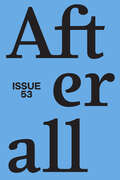- Table View
- List View
After the War: Nation-building from FDR to George W. Bush
by James Dobbins Austin Long Michele A. Poole Benjamin RunkleFrom the post-World War II era through the Cold War, post-Cold War era, and current war on terrorism, this volume assesses how U.S. presidential decisionmaking style and administrative structure can work in favor of, as well as against, the nation-building goals of the U.S. government and military and those of its coalition partners and allies.
After the War: The Press in a Changing America, 1865–1900
by David B. SachsmanAfter the War presents a panoramic view of social, political, and economic change in post-Civil War America by examining its journalism, from coverage of politics and Reconstruction to sensational reporting and images of the American people. The changes in America during this time were so dramatic that they transformed the social structure of the country and the nature of journalism. By the 1870s and 1880s, new kinds of daily newspapers had developed. New Journalism eventually gave rise to Yellow Journalism, resulting in big-city newspapers that were increasingly sensationalistic, entertaining, and designed to attract everyone. The images of the nation’s people as seen through journalistic eyes, from coverage of immigrants to stories about African American "Black fiends" and Native American "savages," tell a vibrant story that will engage scholars and students of history, journalism, and media studies.
After the Waste Land: Democratic Economics for the Year 2000
by David M. Gordon Samuel Bowles Thomas E. WeisskopfThis critique of Reaganomics attempts to provide alternatives to both the supply experiments of the 1980s and neoliberal strategies of austerity. It presents arguments for economic democracy with a worker-oriented blueprint for improving productivity, growth, employment and economic justice.
After the White House: Former Presidents as Private Citizens
by Max J. SkidmoreWhat exactly has Bill Clinton been doing since he left office? What can he expect to accomplish? What have his predecessors in his position done? Many presidents have had enormous impacts on the course of history after their terms ended, but not until After the White House by Max J. Skidmore has their role been examined. Thirty-two completed their terms. Four became presidential candidates again (one was even elected), two served in Congress, one abandoned his country to accept election to the Confederate Congress, one became Chief Justice, and one has the unique distinction of having his First Lady become a United States senator. Former presidents almost always remain influential, but their post-term activities have received little attention or scrutiny until now.
After the Winter (MacLehose Press Editions #10)
by Guadalupe Nettel"I envy how naturally she makes use of language; her resistance to ornamentation and artifice; and the almost stoic fortitude with which she dispenses her profound and penetrating knowledge of human nature. What's more, in this novel, she has impeccable syntactic control, and her ear is sharper than ever before" Valeria Luiselli, GuernicaA shy young Mexican woman moves to Paris to study literature. Cecilia has few friends, and a morbid fascination with watching the funerals taking place in Père-Lachaise cemetery outside her apartment. She suddenly strikes up a close relationship with her neighbour, a sickly young man who shares her interest in death and believes we can communicate with the dead. After coming to entirely depend on him for company and routine, Cecilia is left devastated by his decision to go to Sicily for his health, and is left alone in an unfriendly city once more.Claudio, meanwhile, lives in New York with the submissive, quiet, but very wealthy Ruth. She makes few demands of him, while acquiescing to all his desires and indulging his obsessive, misogynistic nature. He meets Cecilia by chance when visiting a friend in Paris and their two very different worlds collide with transformative consequences.With startling intensity, humour and insight, Nettel conjures a dark fable about obsession, denial and our modern ability to reach out across the globe in search of love.Translated from the Spanish by Rosalind Harvey
After the World Trade Center: Rethinking New York City (Cultural Spaces)
by Michael Sorkin Sharon ZukinThe terrorist attacks of September 11 have created an unprecedented public discussion about the uses and meanings of the central area of lower Manhattan that was once the World Trade Center. While the city sifts through the debris, contrary forces shaping its future are at work. Developers jockey to control the right to rebuild "ground zero." Financial firms line up for sweetheart deals while proposals for memorials are gaining in appeal. In After the World Trade Center, eminent social critics Sharon Zukin and Michael Sorkin call on New York's most acclaimed urbanists to consider the impact of the terrorist attack on the World Trade Center and what it bodes for the future of New York. Contributors take a close look at the reaction to the attack from a variety of New York communities and discuss possible effects on public life in the city.
After the Worst Day Ever: What Sick Kids Know About Sustaining Hope in Chronic Illness
by Duane R. BidwellFor those who care for chronically ill children, a new understanding of hope that equips adults to better nurture pediatric hope among sick kids—articulated by the children themselvesAs anyone with a chronic illness knows, hope can sometimes be hard to come by. For parents and caregivers of children with serious illness, there can be a real struggle to move beyond one's own grief, fear, and suffering to see what hope means for these kids.Duane Bidwell, a scholar, minister, and former hospital chaplain who has struggled with serious illness himself, spent time with 48 chronically ill children in dialysis units and transplant clinics around the United States. Chronically ill kids, he found, don&’t adhere to popular or scholarly understandings of hope. They experience hope as a sense of well-being in the present, not a promise of future improvement, an ability to set goals, or the absence of illness and suffering. With this mindset, these kids suggest a new understanding of pediatric hope, saying hope becomes concrete when they (1) realize community, (2) claim power, (3) attend to Spirit, (4) choose trust, and (5) maintain identity.Offering textured portraits of children with end-stage kidney disease, After the Worst Day Ever illustrates in their words how sick children experience, maintain, and turn toward hope even when illness cannot be cured and severely limits quality of life. Their insights reveal how the adults in a sick child's world—parents, chaplains, medical professionals, teachers, and others—can nurture hope. They also shift our understanding of hope from an internal resource located &“inside&” an individual to a shared, communal experience that becomes a resource for individuals.Rich and moving, Bidwell&’s work helps us imagine anew what it means to sustain hope despite inescapable suffering and the limits of chronic illness.
After the Worst has Happened: Tales from a funeral director on the lighter side of death
by Richard GoslingWhen Richard Gosling's young daughter faced emergency surgery, a colleague carelessly asked what would happen if she died. In that moment, Richard was forced to picture his own daughter's funeral, and the people who are there to help families after the worst has happened.Aged 40, Richard left his job in the public service and started preparing coffins, driving hearses, assisting in the mortuary and bringing in the deceased from hospitals and nursing homes, slowly working his way up to become operations manager of a venerable Sydney funeral home.After the Worst Has Happened lifts the curtain on a world we all try to avoid but must pass through. It shows the lighter side of death amid all its other facets, as Richard steers families through heartbreak, anger and grief while holding space for love and acceptance. Ultimately, it's about how extraordinarily beautiful it can be to spend a daily life surrounded by our final rite of passage.
After the Worst has Happened: Tales from a funeral director on the lighter side of death
by Richard GoslingWhen Richard Gosling's young daughter faced emergency surgery, a colleague carelessly asked what would happen if she died. In that moment, Richard was forced to picture his own daughter's funeral, and the people who are there to help families after the worst has happened.Aged 40, Richard left his job in the public service and started preparing coffins, driving hearses, assisting in the mortuary and bringing in the deceased from hospitals and nursing homes, slowly working his way up to become operations manager of a venerable Sydney funeral home.After the Worst Has Happened lifts the curtain on a world we all try to avoid but must pass through. It shows the lighter side of death amid all its other facets, as Richard steers families through heartbreak, anger and grief while holding space for love and acceptance. Ultimately, it's about how extraordinarily beautiful it can be to spend a daily life surrounded by our final rite of passage.
After-Dinner Conversation: The Diary of a Decadent
by José Asunción SilvaLost in a shipwreck in 1895, rewritten before the author's suicide in 1896, and not published until 1925, José Asunción Silva's After-Dinner Conversation (De sobremesa) is one of Latin America's finest fin de siècle novels and the first one to be translated into English. Perhaps the single best work for understanding turn-of-the-twentieth-century writing in South America, After-Dinner Conversation is also cited as the continent's first psychological novel and an outstanding example of modernista fiction and the Decadent sensibility. Semi-autobiographical and more important for style than plot, After-Dinner Conversation is the diary of a Decadent sensation-collector in exile in Paris who undertakes a quest to find his beloved Helen, a vision whom his fevered imagination sees as his salvation. Along the way, he struggles with irreconcilable urges and temptations that pull him in every direction while he endures an environment indifferent or hostile to spiritual and intellectual pursuits, as did the modernista writers themselves. Kelly Washbourne's excellent translation preserves Silva's lush prose and experimental style. In the introduction, one of the most wide-ranging in Silva criticism, Washbourne places the life and work of Silva in their literary and historical contexts, including an extended discussion of how After-Dinner Conversation fits within Spanish American modernismo and the Decadent movement. Washbourne's perceptive comments and notes also make the novel accessible to general readers, who will find the work surprisingly fresh more than a century after its composition.
After-School Centers and Youth Development
by Nancy L. Deutsch David L. Dubois Barton J. HirschThis book examines after-school programs in light of their explosive growth in recent years. In the rush to mount programs, there is a danger of promoting weak ones of little value and failing to implement strong ones adequately. But what is quality and how can it be achieved? This book presents findings from an intensive study of three after-school centers that differed dramatically in quality. Drawing from 233 site visits, the authors examine how - and why - young people thrive in good programs and suffer in weak ones. The book features engaging, in-depth case studies of each of the three centers and of six youths, two from each center. Written in a highly accessible style for academics, youth workers, after-school program leaders and policy makers, the study breaks new ground in highlighting the importance of factors such as collective mentoring, synergies among different programs and activities, and organizational culture and practices.
After-School Prevention Programs for At-Risk Students: Promoting Engagement and Academic Success
by Elaine Clanton HarpineAfter-School Prevention Programs for At-Risk Students offers professionals a detailed framework for developing and enhancing after-school programs. Emphasizing a prevention focus and a group-centered interactive approach, the book's year-long model combines education and counseling, incorporating key therapeutic objectives to foster academic and behavior skills and reduce problems in and outside class. Practical step-by-step guidelines for creating and implementing programs include clear rationales, instructive design and case examples, and ready-to-use interventions. The author also provides guidance on developmental, gender, and cultural considerations, the challenges of maintaining progress over the course of the school year, and the handling of severe learning and emotional problems. Among the topics covered: Organizing a group-centered after-school program.Combining learning and counseling into one curriculum.The role of motivation in an ongoing year-long program.Group process, self-efficacy, cohesion: applying the principles of change.Interaction in a year-long program.Solving problems and conflicts. After-School Prevention Programs for At-Risk Students is an essential reference for scientist-practitioners, clinicians, and academics in such disciplines as school psychology, childhood education, social work, psychotherapy and counseling, and learning and instruction.
After-School Programming and Intrinsic Motivation: Teaching At-Risk Students to Read
by Elaine Clanton HarpineThis book examines the eight-year development of the Reading Orienteering Club after-school program, showing how to develop, test, change, and adapt an after-school program to fit the needs of the children who attend. It includes case studies and data reports for each year and presents the theory, application, and program evaluation steps that workers in the field or students learning about program design must follow. Chapters present first-person accounts as well as statistical evaluations of the effectiveness of the reading program with each group of children. In addition, chapters highlight the changes that were made in program design and why each change was implemented, giving practitioners the insights needed to adapt interventions and strategies to their own programs. The book concludes with recommendations from the authors on how to run a successful after-school reading program. Topics featured in this book include:The effect of intrinsic motivation to mental wellness in the classroom.The importance of oral reading in correcting reading failure.Group-center approaches to teaching reading in the classroom.How to select the best evaluation tool.The challenges of mixing inner city and rural students in a reading program. After-School Programming and Intrinsic Motivation is an essential reference for scientist-practitioners, clinicians, researchers, and graduate students in such disciplines as school psychology, childhood education, social work, psychotherapy and counseling, and learning and instruction.
After-School Programs to Promote Positive Youth Development: Integrating Research into Practice and Policy, Volume 1 (SpringerBriefs in Psychology)
by Nancy L. DeutschThe first volume of this SpringerBrief presents a series of papers compiled from a conference about how after-school programs may be implemented to promote positive youth development (PYD) hosted by Youth-Nex, the University of Virginia Center to Promote Effective Youth Development. This volume reviews the importance of after-school programs for PYD and discusses key components of effective after-school programs. It also discusses issues related to the evaluation and measurement of quality in after-school programs. In addition, the brief presents suggestions for how researchers, policy makers, and practitioners can move the field forward and maximize the potential of after-school time and programs for promoting positive youth development for children and adolescents. Topics featured in this brief include: The history of the relationship between after-school programs and positive youth development. Specific features of programs that are important for advancing positive youth development. Issues in and approaches to measuring quality in after-school programs. The Quality, Engagement, Skills, Transfer (QuEST) model and its use for measuring effective after-school programs. A case study evaluation of the Girls on the Run program. After-School Programs to Promote Positive Youth Development, Volume 1, is a must-have resource for policy makers and related professionals, graduate students, and researchers in child and school psychology, family studies, public health, social work, law/criminal justice, and sociology.
After-School Programs to Promote Positive Youth Development: Learning from Specific Models, Volume 2 (SpringerBriefs in Psychology)
by Nancy L. DeutschThe first volume of this SpringerBrief presents a series of papers compiled from a conference about how after-school programs may be implemented to promote positive youth development (PYD) hosted by Youth-Nex, the University of Virginia Center to Promote Effective Youth Development. This volume reviews the importance of after-school programs for PYD and discusses key components of effective after-school programs. It also discusses issues related to the evaluation and measurement of quality in after-school programs. In addition, the brief presents suggestions for how researchers, policy makers, and practitioners can move the field forward and maximize the potential of after-school time and programs for promoting positive youth development for children and adolescents. Topics featured in this brief include: The history of the relationship between after-school programs and positive youth development. Specific features of programs that are important for advancing positive youth development. Issues in and approaches to measuring quality in after-school programs. The Quality, Engagement, Skills, Transfer (QuEST) model and its use for measuring effective after-school programs. A case study evaluation of the Girls on the Run program. After-School Programs to Promote Positive Youth Development, Volume 1, is a must-have resource for policy makers and related professionals, graduate students, and researchers in child and school psychology, family studies, public health, social work, law/criminal justice, and sociology.
After-sales Service of Engineering Industrial Assets: A Reference Framework for Warranty Management
by Adolfo Crespo Márquez Vicente González-Prida DíazThis book explores the practical implementation of an advanced after-sales management framework devoted to warranty management. The framework is intended for companies producing either standardized or customized products and such a management tool will facilitate organizational improvement and support innovative decision making processes for technical assistance in after-sales services. "After-sales Service of Engineering Industrial Assets" comprises a proposal for a warranty management framework, with an account of the different methods that can be used to improve decision making in the different stages of the after-sales service management process, and strategies for strengthening the structure and foundations of the framework. A review of the fundamental issues and current research topics in warranty management and after sales services is also provided, which is exemplified by a case study. This book is intended for postgraduates, researchers and engineers who are interested in after sales management, assets engineering and warranty management.
After-school Programs To Promote Child And Adolescent Development: Summary Of A Workshop
by Committee on Community-Level Programs for YouthInformation on After-school Programs To Promote Child And Adolescent Development.
After...: The Impact of Child Abuse
by Libby Moore'A kind, tough, brave, important little story ... it will be a godsend to so many people, grown, growing and very young' - Joanna Lumley OBEI want to talk about the things that are happening to you... to us.As a little girl, Libby Moore was sexually abused by someone she should have been able to trust. Sadly, her experience is not uncommon. Many vulnerable children find themselves trapped in similarly devastating situations.Abuse leaves indelible marks; Libby lives with severe low self-esteem that has affected her relationships, career and choices into adulthood. She wishes that she could have supported and comforted her younger self, and explained that even when darkness seems all around light still exists. After... is Libby's way of reaching out and reconnecting with her younger self - and to all other survivors of child abuse.Essential and heart-breaking, with powerful and expressive illustrations by acclaimed cartoonist Tony Husband, this is a compelling and universal personal story. It will comfort and inspire anyone who has suffered childhood violence and abuse, and act as a trusted, therapeutic resource. Full of sensitivity and understanding, it takes a clear-sighted look at how trauma can affect and shape us and explains how through self-compassion we can learn to embrace life and begin to live again.
After...: The Impact of Child Abuse
by Libby Moore'A kind, tough, brave, important little story ... it will be a godsend to so many people, grown, growing and very young' - Joanna Lumley OBEI want to talk about the things that are happening to you... to us.As a little girl, Libby Moore was sexually abused by someone she should have been able to trust. Sadly, her experience is not uncommon. Many vulnerable children find themselves trapped in similarly devastating situations.Abuse leaves indelible marks; Libby lives with severe low self-esteem that has affected her relationships, career and choices into adulthood. She wishes that she could have supported and comforted her younger self, and explained that even when darkness seems all around light still exists. After... is Libby's way of reaching out and reconnecting with her younger self - and to all other survivors of child abuse.Essential and heart-breaking, with powerful and expressive illustrations by acclaimed cartoonist Tony Husband, this is a compelling and universal personal story. It will comfort and inspire anyone who has suffered childhood violence and abuse, and act as a trusted, therapeutic resource. Full of sensitivity and understanding, it takes a clear-sighted look at how trauma can affect and shape us and explains how through self-compassion we can learn to embrace life and begin to live again.
After: A Doctor Explores What Near-Death Experiences Reveal about Life and Beyond
by Bruce GreysonThe world's leading expert on near-death experiences reveals his journey toward rethinking the nature of death, life, and the continuity of consciousness.Cases of remarkable experiences on the threshold of death have been reported since ancient times, and are described today by 10% of people whose hearts stop. The medical world has generally ignored these “near-death experiences,” dismissing them as “tricks of the brain” or wishful thinking. But after his patients started describing events that he could not just sweep under the rug, Dr. Bruce Greyson began to investigate.As a physician without a religious belief system, he approached near-death experiences from a scientific perspective. In After, he shares the transformative lessons he has learned over four decades of research. Our culture has tended to view dying as the end of our consciousness, the end of our existence—a dreaded prospect that for many people evokes fear and anxiety.But Dr. Greyson shows how scientific revelations about the dying process can support an alternative theory. Dying could be the threshold between one form of consciousness and another, not an ending but a transition. This new perspective on the nature of death can transform the fear of dying that pervades our culture into a healthy view of it as one more milestone in the course of our lives. After challenges us to open our minds to these experiences and to what they can teach us, and in so doing, expand our understanding of consciousness and of what it means to be human.
After: How America Confronted the September 12 Era
by Steven BrillThe story begins on September 12, 2001. It reads like a novel. But the characters in award-winning journalist Steven Brill's America are real. They don't have all the answers or all the virtues of fictional heroes. It is because they are so human -- so much like the rest of us -- that makes the way they rise to the challenge of September 12 such an inspiring story about how America really works. A Customs inspector somehow has to guard against a nuclear bomb that could be hidden in one of the thousands of cargo containers from all over the world sitting on his dock in New York harbor. A young woman in New Jersey, suddenly widowed with three young children, doesn't know how to get the keys to her husband's car, much less how she can challenge the head of a federal victims' fund. An entrepreneur in Silicon Valley, who makes machines that screen luggage for bombs, can't decide if this crisis is an opportunity he should seize. Attorney General John Ashcroft has no idea how to find the new, hidden enemy living among us. The young, just-hired director of the American Civil Liberties Union wonders how he can keep Ashcroft from going too far. The CEO of a giant insurer has to decide whether to risk economic panic by not paying damage claims that he might legally be able to avoid. Red Cross President Bernadine Healy has to figure out how to collect and allocate donations while dodging a hostile board of directors. Career civil servant Gale Rossides has to recruit and train the largest workforce ever hired by the government -- the new airport passenger screeners. A proprietor of a shoe repair shop -- helped by two young women, pro bono lawyers -- has to rebuild a business buried in the rubble of Ground Zero. A Detroit Border Patrol agent -- whose bosses want to fire him for speaking out about how unprotected his stretch of border is -- has to choose whether to risk his family's livelihood by sounding the alarm. Tom Ridge has to run through a bureaucratic wall to mount a true homeland security defense. Drawing on 347 on-the-record interviews and revelations from memos of government meetings, court filings, and other documents, Brill gives us a front-row seat as these and other players in this real-life drama cross paths in a series of alliances and confrontations and fight for their own interests and their version of the public interest. The result is a gritty story -- and trailblazing journalism -- that inspires us not because these Americans or their country are perfect, but because they were tough enough, anchored enough, and living in a system that encouraged and enabled them to meet the awesome challenges they faced.
Afterall: A Journal of Art, Context and Enquiry, volume 51 number 1 (Spring 2021)
by Afterall: A Journal of Art, Context and EnquiryThis is volume 51 issue 1 of Afterall: A Journal of Art, Context and Enquiry. Afterall is a journal of contemporary art that provides in-depth analysis of art and its social, political, and philosophical contexts. Each issue provides the reader with well-researched contributions that discuss each artist's work from different perspectives. Contextual essays and other texts discussing events, works, or exhibitions further develop the thematic focus of each issue.
Afterall: A Journal of Art, Context and Enquiry, volume 52 number 1 (Autumn/Winter 2021)
by Afterall: A Journal of Art, Context and EnquiryThis is volume 52 issue 1 of Afterall: A Journal of Art, Context and Enquiry. Afterall is a journal of contemporary art that provides in-depth analysis of art and its social, political, and philosophical contexts. Each issue provides the reader with well-researched contributions that discuss each artist's work from different perspectives. Contextual essays and other texts discussing events, works, or exhibitions further develop the thematic focus of each issue.
Afterall: A Journal of Art, Context and Enquiry, volume 53 number 1 (Spring 2022)
by Afterall: A Journal of Art, Context and EnquiryThis is volume 53 issue 1 of Afterall: A Journal of Art, Context and Enquiry. Afterall is a journal of contemporary art that provides in-depth analysis of art and its social, political, and philosophical contexts. Each issue provides the reader with well-researched contributions that discuss each artist's work from different perspectives. Contextual essays and other texts discussing events, works, or exhibitions further develop the thematic focus of each issue.
Afterall: A Journal of Art, Context and Enquiry, volume 54 number 1 (Autumn/Winter 2022)
by Afterall: A Journal of Art, Context and EnquiryThis is volume 54 issue 1 of Afterall: A Journal of Art, Context and Enquiry. Afterall is a journal of contemporary art that provides in-depth analysis of art and its social, political, and philosophical contexts. Each issue provides the reader with well-researched contributions that discuss each artist's work from different perspectives. Contextual essays and other texts discussing events, works, or exhibitions further develop the thematic focus of each issue.
